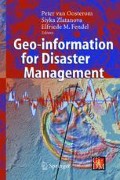Abstract
The existence of elevation errors in the Digital Elevation Models (DEMs) usually is ignored, during spatial analysis of risk assessment and disaster management problems. As a result, conclusions are extracted, decisions are taken and actions are designed and executed, while the problem is examined on a wrong point of view. This paper describes the attempt to introduce a new model, the DEEM (Digital Elevation Error Model), which incorporates elevation uncertainty and accompanies a DEM uniquely. The use of an uncertain DEM, combined with a probabilistic “soft” decision approach, eliminates the risk of taking decisions that do not imply to the real problem’s basis. Research has shown deviations existing in results, up to 20–50% for volume measurements, area measurements, definition of boundaries, visibility calculation, etc., from those of a “hard” decision approach. The absence of an integrated GIS, able to manage data uncertainty, forces for by-pass approaches of the problem but not the appropriate ones.
Access this chapter
Tax calculation will be finalised at checkout
Purchases are for personal use only
Preview
Unable to display preview. Download preview PDF.
References
Achilleos G (2002a) Study of Errors in the Procedures of Digitizing Contour Lines and Generating Digital Elevation Models, PhD Thesis, Lab. of Geography & Spatial Analysis, School of Rural & Surveying Engineers, National Technical University of Athens, Athens (greek language).
Burrough PA (1986) Principles of Geographical Information Systems for Land Resources Assessment, Oxford University Press, Great Britain.
Carter JR (1988) Relative Errors Identified in USGS Gridded Models, Proceedings of Ninth International Symposium on Computer-Assisted Cartography, Baltimore, Maryland, AUTOCARTO 9.
Cressie NAC (1991) Statistics for Spatial Data, John Wiley and Sons, Inc., New York.
Davis JC (1973) Statistics and Data Analysis in Geology, John Wiley & Sons, Inc., USA.
Fisher PF (1993) Algorithm and Implementation Uncertainty in Viewshed Analysis, International Journal of Geographical Information Systems, Vol. 7, No. 4, pp. 331–347.
Fisher PF (1995) An Exploration of Probable Viewsheds in Landscape Planning, Environment and Planning B: Planning and Design, Vol. 22, pp. 527–546.
Li Z (1992) Variation of the Accuracy of Digital Terrain Models with Sampling Intervals, Photogrammetric Record, 14(79), April 1992, pp. 113–128.
Li Z (1993) Mathematical Models of the Accuracy of Digital Terrain Model Surfaces Linearly Constructed from Square Gridded Data, Photogrammetric Record, 14(82), pp. 661–674.
Mikhail E (1978) Panel Discussion: The Future of DTM (presented at the ASP DTM Symposium, May 9–11, 1978, St.Louis, MO), Photogrammetric Engineering & Remote Sensing, Vol. 44, No. 12, pp 1487–1497.
Ostman A (1987) Accuracy Estimation of Digital Elevation Data Banks, Photogrammetric Engineering & Remote Sensing, Vol. 53, No. 4, pp. 425–430.
Richardus P (1973) The Precision of Contour Lines and Contour Intervals of Large-and Medium-Scale Maps, Photogrammetria, 29, pp.81–107.
Robinson GJ (1994) The Accuracy of Digital Elevation Models Derived from Digitised Contour Data, Photogrammetric Record, 14(83), pp. 805–814.
Soulantzos G (2001) Fuzzy Logic in certain Location Problems, Journal of Hellenic Association of Rural & Surveying Engineers (greek language).
Veis G, Agantza — Mbalodimou A (1989) Error Theory and Least Squares Methods, Semester Teaching Notes, School of Rural & Surveying Engineers, National Technical University of Athens, Athens (greek language).
Wenzhong S, Ehlers M, Tempfli K (1994) Modeling and Visualizing Uncertainties in Multi-Data-Based Spatial Analysis, Proceedings of EGIS / MARI’ 94, Paris, pp. 454–464.
Wenzhong S, Tempfli K (1994), Modelling Positional Uncertainty of Line Features in GIS, ASPRS/ACSM, Annual Convention & Exposition Technical Papers, Nevada, pp. 696–705.
Yoeli P (1984) Error-Bands of Topographical Contours with Computer and Plotter (Program Koppe), Geo-Processing, 2, pp. 287–297.
Zadeh LA (1965) Fuzzy Sets, Information and Control, 8: 338–353.
Author information
Authors and Affiliations
Editor information
Editors and Affiliations
Rights and permissions
Copyright information
© 2005 Springer-Verlag Berlin Heidelberg
About this chapter
Cite this chapter
Achilleos, G.A. (2005). Considering Elevation Uncertainty for Managing Probable Disasters. In: van Oosterom, P., Zlatanova, S., Fendel, E.M. (eds) Geo-information for Disaster Management. Springer, Berlin, Heidelberg. https://doi.org/10.1007/3-540-27468-5_17
Download citation
DOI: https://doi.org/10.1007/3-540-27468-5_17
Publisher Name: Springer, Berlin, Heidelberg
Print ISBN: 978-3-540-24988-7
Online ISBN: 978-3-540-27468-1
eBook Packages: Earth and Environmental ScienceEarth and Environmental Science (R0)

